06 Are there traces of Hepatophilic Virus in Your Body-
Appearance of the Tongue – ?
A traditional Chinese doctor attaches great importance to the diagnosis of the tongue to determine hepatophilic virus diseases. From the appearance of the tongue, a physician of traditional Chinese medicine can judge the state of the internal organs and blood from the appearance of the tongue, which provides a basis for the physician to determine the use of herbal medicine.
The normal shape of the tongue is an elongated oval, not thick nor thin and located in the center of the mouth. The color is light red, bright with moisture. The tongue should not be furred and it should be capable of moving freely. Some scholar pointed out in 1957 that a hepatocirrhosis patient would show a "tongue of liver ailment" which may show a bluish red, pinkish red or lacquer-like red, swollen, too much moisture on the membrane and no obvious fur. Our observation of nearly 2000 cases of patients with abnormal margin in the liver region shows a patient affected by chronic hepatophilic virus usually show tongue appearance as follows:
Color of the Tongue
1. Scarlet: It is often a symptom of exuberance of the vital function of the liver due to deficiency of vital essence caused by deficiency of vital essence of the kidney leading to deficiency of the vital essence of the liver, showing heat symptom at the early stage and fire symptom brought on by deficiency of vital essence and blood at the later stage. Indications include bright red at the center of the tongue and scarlet at the sides of the tongue due to heat in the liver, with complicated hypertension, thyroidism, diabetes and like diseases.
2. Light color: When the tongue is light in color, it is an indication of cold due to a deficiency of vital energy, mostly shown in patients suffering from deficiency of the vital energy and vital essence, with light color of the tongue for deficiency of vital essence, vital energy and deficiency of the vital essence of the spleen. When it is a serious case of chronic anemia, the tongue is as white as washed, complicated with whitish tongue membrane and conjunctiva, with symptoms of low voice, weak breathing, strenuous throbbing of the heart, dizziness, tinnitus, spontaneous sweating, light color of lips and tired complexion.
Photos showing thick tongue with tooth prints on the side of the tongue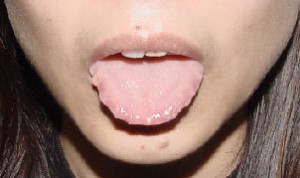
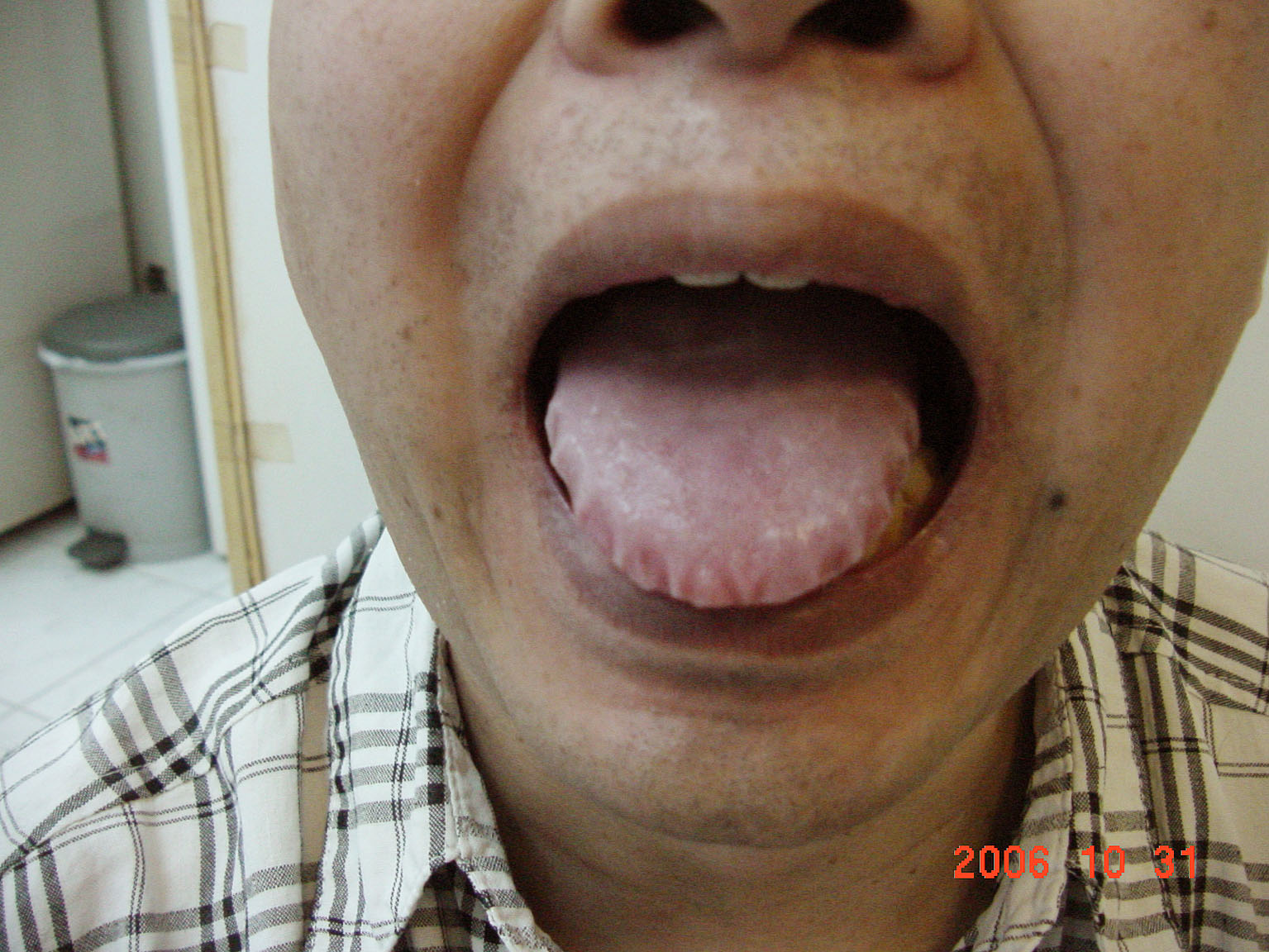
Quality of the Tongue
1. Tongue thick with prints of teeth at side:
When a patient of chronic hepatitis belongs to the type of exuberant dampness and heat, the symptoms are obvious signs of dampness and heat. As a result of the accumulation of antigen-antibody
in the human body, there is lots of inflammation water remaining. This, plus a low level of protein in the blood, leads to hepatic edema. A patient with clinical indications of hepatic edema often shows a swollen tongue with tooth print on the sides and thick round tip of the tongue. When there are prints of teeth on the sides of the tongue, the patient often has swollen lower limbs. When symptoms of dampness in the liver is obvious, the tooth print on the sides of the tongue is most obvious. Common clinical symptoms are swollen body, fatigue, sore muscles all over, sleepiness or insomnia, feeling heavy and weak lower limbs or even numbness and when pressing on tibia, depression is shown on the skin. Treatment with systematic Chinese medication yields marked improvement.
2. Ecchymosis on the Sides of the Tongue
A patient of chronic hepatic ecchymosis often shows dark purplish spots on the tongue, with red, purple or black patches or spots scattered on the tip and sides of the tongue. Clinical symptoms are found on patients with complications of benign tumors (such as hystermyoma) or malignant tumors (such as haopharyngeal carcinoma). When a patient of chronic hepatitis is cured with the systematic Chinese medication, the area of ecchymosis shrinks and the color of the spots becomes light and may disappear.
Photos below shows dark spots on the tongue of a chronic hepatitis patient.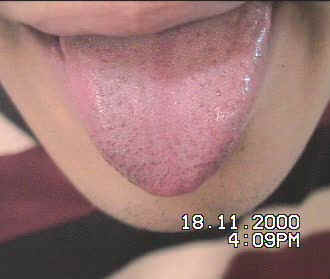
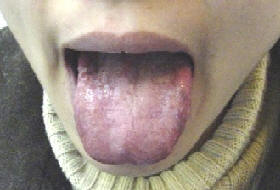
3. Prickled Tongue Surface and Partial shedding of Fur
The prickled tongue surface is an indication of an excessiveness of heat in the internal organs. If the tongue surface is smooth and scarlet red, the smooth surface is the result of the shedding of fur and lack of moisture. In the view of traditional Chinese medicine, it is the result of spent fluid of the vital essence of the stomach and kidneys.
4. Fissured Tongue
The fissured tongue is generally believed an indication of atrophia of the membrane, with the fissures running horizontally or lengthwise, or in serious cases, like a net. When an infant contracts hepatophilic virus, fissured tongue may show up in adolescence or youth. Systematic Chinese medication can improve it, which seems to refute the belief that fissured tongue is congenital.
5. The Furred Tongue
The furred tongue is an indication of dampness arising from the spleen under the fire of the stomach and the varying degrees of the swelling and color of the furred tongue provides reference for Chinese medication. Generally speaking, there are thick, thin fur in white, yellow and dark as follows:
(a) White Fur
White furred tongue may occur in cases of internal and external symptoms, cold or heat, deficiency of the vital energy or vital essence, according to the theory of traditional Chinese medicine. It is said: "The lungs are related to the color of white and are in charge of the skin and hair. So when there is white furred tongue, it relates to exterior sydrome."
In cases of chronic hepatitis with heat in the lungs or dampness and heat, the tongue shows white fur while the thickness of the fur varies in keeping with the gravity of the disease. After medication of herbal medicine, the white disappears. But in some cases, the white fur is rather obstinate, an indication of damages to the internal organs. Data indicate that if the tongue tip is white while the root is red and the fur is smooth, the ailment has penetrated half deep. If the fur is white and thick and sticky, it is an indication of dampness and cold in the spleen and stomach. White fur with little saliva is an indication of excessive heat.
The book "Observation of the Tongue as a Guide in Diagnosis" in touching up the relationship between the white fur of the tongue with dampness and heat in the liver says: "White fur on a scarlet tongue is an indication of dampness and heat in the hiding." When the fur of the tongue is white and pulsation feeble, it is an indication of a deficiency of the vital essence with dampness and heat." "When the fur of the tongue is white on a base of deep scarlet with sticky saliva, it means that epidemic febrile pathogenic factors may have penetrated deep into the organs with dampness and heat hidden." All this shows that for thousands of years Chinese medicine has rich literature on clinical experience in observing the appearance of the furred tongue resulting from affection by hepatophilic virus, thus providing guidance for medication with Chinese medicine.
Photos below showing a swollen tongue covered by white fur
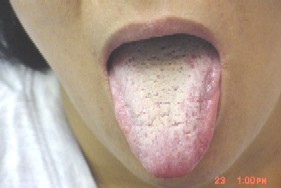
|

|
(b) Yellow Fur
Yellow sticky fur of the tongue is an indication of deep heat and dampness in the digestive system with accumulation of disintegrated organic matter in the digestive tracts. Chinese medical writings say: "When noxious factors invade the deep part of the body called Yangming, the internal heat is rife and the fur of the tongue turns yellow." This indicates that the noxious factors have penetrated deep into the body and turn into heat, showing fire in the heart, lungs, liver and large intestine. If yellow fur covers the whole of the tongue, it is an indication of heat in the organs in both the upper and lower trunk, with signs of internal heat by complications of bitter taste and dry throat, uneasiness and insomnia, red eyes, yellow turbid urine, or poor appetite, loose bowels, etc.
(below: a deep red tongue with dark fur on top of thick yellow fur)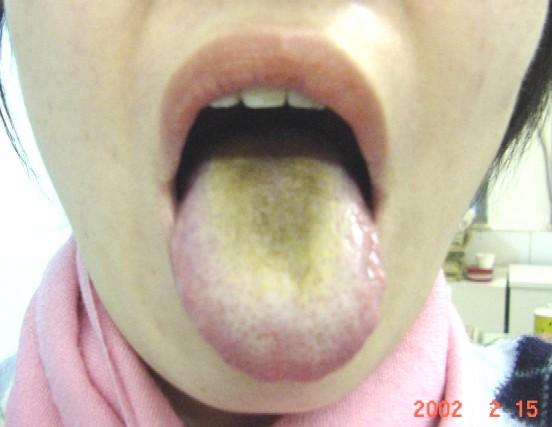
(below: a thick tongue with shedding of membrane and yellow fur)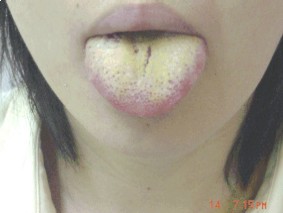
(c) Black Fur
The formation of dark fur is mainly resulted from the turning black of the filiforms of the tongue with the color being brownish black, grayish black or charcoal black or even pitch dark. This occurs usually in cases of chronic ailment or serious cases. That is why Chinese medical books say: "A black furred tongue is an indication of a serious case which may be cold or heat, deficiency of either vital energy or vital essence. All are interior symptom-complex, not exterior symptom-complex. In any case of a black furred tongue, it is heat in the internal part and extreme heat hurting the vital essence. It is an indication of either cold or heat in the extreme. The late stage of a chronic hepatitis with excessive heat may show extreme heat and deficiency of the vital essence in the liver and kidneys, and when saliva is exhausted, the disease becomes extremely serious.










